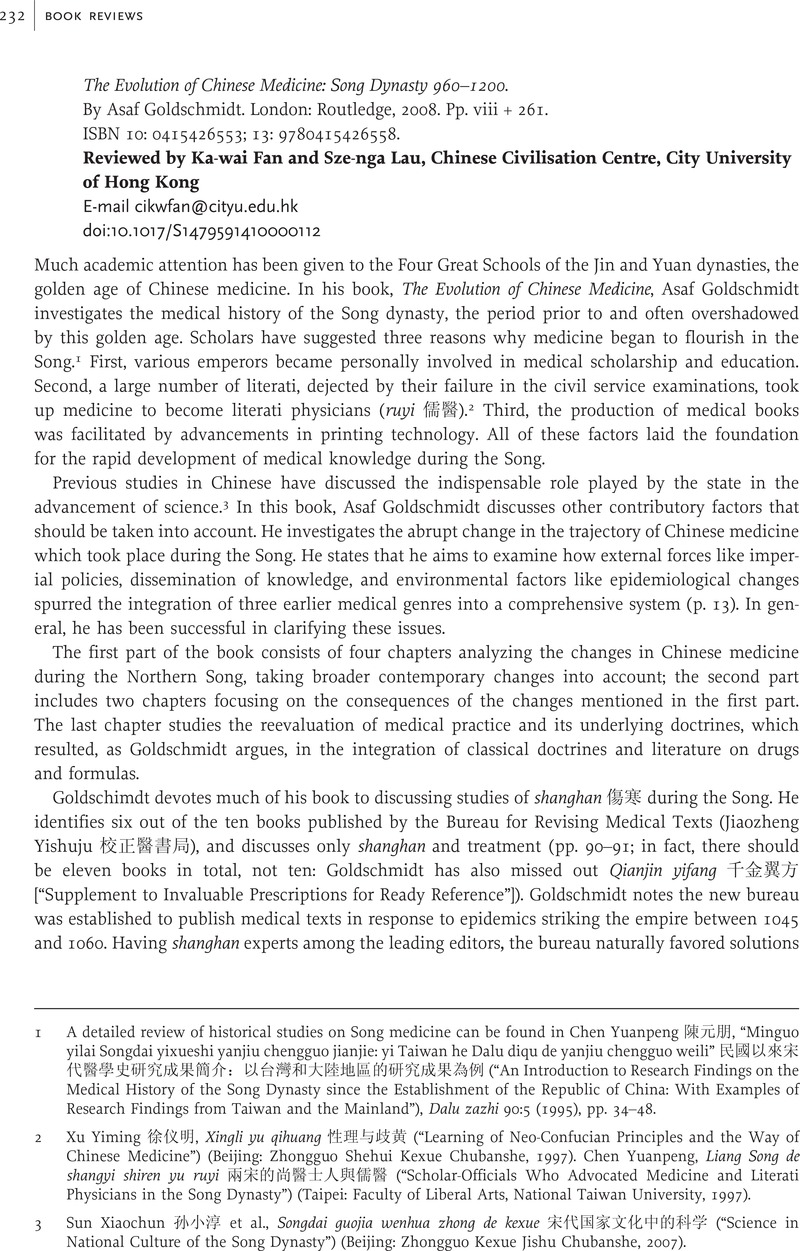No CrossRef data available.
Published online by Cambridge University Press: 15 June 2010

1 A detailed review of historical studies on Song medicine can be found in Chen Yuanpeng 陳元朋, “Minguo yilai Songdai yixueshi yanjiu chengguo jianjie: yi Taiwan he Dalu diqu de yanjiu chengguo weili” 民國以來宋代醫學史研究成果簡介:以台灣和大陸地區的研究成果為例 (“An Introduction to Research Findings on the Medical History of the Song Dynasty since the Establishment of the Republic of China: With Examples of Research Findings from Taiwan and the Mainland”), Dalu zazhi 90:5 (1995), pp. 34–48.
2 Xu Yiming 徐仪明, Xingli yu qihuang 性理与歧黄 (“Learning of Neo-Confucian Principles and the Way of Chinese Medicine”) (Beijing: Zhongguo Shehui Kexue Chubanshe, 1997). Chen Yuanpeng, Liang Song de shangyi shiren yu ruyi 兩宋的尚醫士人與儒醫 (“Scholar-Officials Who Advocated Medicine and Literati Physicians in the Song Dynasty”) (Taipei: Faculty of Liberal Arts, National Taiwan University, 1997).
3 Sun Xiaochun 孙小淳 et al., Songdai guojia wenhua zhong de kexue 宋代国家文化中的科学 (“Science in National Culture of the Song Dynasty”) (Beijing: Zhongguo Kexue Jishu Chubanshe, 2007).
4 Hinsch, Bret, “Climatic Change and History in China,” Journal of Asian History 22:2 (1988), pp. 131–59Google Scholar; Xu Shengyi 徐勝一 and Xiao Weile 蕭偉樂, “Songdai qihou bianqian yu Wang Anshi bianfa shimo” 宋代氣候變遷與王安石變法始末 (“Climate Change and Wang Anshi's Reforms in the Song Dynasty”), www.geo.ntnu.edu.tw/old%20980202/laboratory/climate/word/sung.pdf (accessed 10 October 2009).
5 Cao Shuji 曹樹基, “Dili huanjing yu Song-Yuan shidai de chuanranbing” 地理環境與宋元時代的傳染病 (“Geographical Environment and Infectious Diseases in the Song and Yuan Dynasties”), Lishi dili 12 (1995), pp. 183–92.
6 Xiao Fan 蕭璠, “Han-Song jian wenxian suojian gudai Zhongguo nanfang de dili huanjing yu difangbing ji qi yingxiang” 漢宋間文獻所見古代中國南方的地理環境與地方病及其影響 (“The Physical Environment and Endemic Diseases of South China in Ancient Times and Their Impact as Viewed from the Documents of Han through Song Periods”), Zhongyang yanjiuyyuan lishi yuyan yanjiusuo jikan 中央研究院歷史語言研究所集刊 [Bulletin of the Institute of History and Philology, Academia Sinica] 63:1 (1993), pp. 67–171. Fan Kawai 范家偉, “Liuchao shiqi renkou qianyi yu Lingnan diqu zhangqibing” 六朝時期人口遷移與嶺南地區瘴氣病 (“The Infection Zhang Qi Bing and Population Migration in Lingnan Region during the Six Dynasties”), Hanxue yanjiu [Chinese Studies] 16:1 (1998), pp. 27–58.
7 Xiao, ibid.
8 More examples can be found in Fan Kawai, Dayi jingcheng: Tangdai guojia, xinyang yu yixue 大醫精誠: 唐代國家、信仰與醫學 (“Great Medicine, Precise and Sincere: Tang State, Religions and Medicine”) (Taibei: Dongda, 2007).
9 Kawai, Fan, “Foot Massage in Chinese Medical History,” Journal of Alternative and Complementary Medicine: Research on Paradigm, Practice, and Policy 12:3 (2006), pp. 1–3Google Scholar.
10 Jin Zhongshu 金中樞, “Songdai jizhong shehui fuli zhidu- Juyangyuan, Anjifang, Louzeyuan” 宋代幾種社會福利制度: 居養院、安濟坊、漏澤園 (“On the Social Welfare System in the Song Dynasty: Juyangyuan, Anjifang and Louzeyuan”), Xinya xueshu niankan 10 (1968), pp. 127–69; Huang Minzhi 黃敏枝, “Songdai de sengren yu yiliao” 宋代的僧人與醫療 (“Buddhist Monks and Medicine in the Song Dynasty”), in Lishi shang de cishan huodong yu shehui dongli 歷史上的慈善活動與社會動力 (“Charitable Activities and Social Dynamic in History”), eds. Zhang Xueming 張學明 and Liang Yuansheng 梁元生 (Hong Kong: Xianggang Jiaoyu Tushu Gongsi, 2005), pp. 26–78. Liu Shufen 劉淑芬, “Tangsong shiqi sengren, guojia yu yiliao de guanxi” 唐宋時期僧人、國家與醫療的關係 (“The Relations among Buddhist Monks, State, and Medicine in Tang-Song Periods”), Cong yiliao kan Zhongguo shi (“Viewing Chinese History Through Medicine”) (Taipei: Lian jing, 2008), pp. 145–202.
11 Fan Kawai, “Tang-Song shidai Jinzhou liaofa jieshi de zhuanbian” 唐宋時代禁咒療法解釋的轉變 (“The Changes in the Interpretation of Therapeutics with Incantations during the Tang and Song Periods”), in Shixue Xinchuan 史學薪傳, Hong Kong: Zhonghua Shuju, 2005, pp. 249–67. Ts'un-yan, Liu, “The Taoists' Knowledge of Tuberculosis in the Twelfth Century,” Selected Papers from the Hall of Harmonious Wind (Leiden: E. J. Brill, 1976), pp. 59–75Google Scholar.